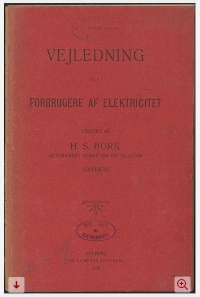DTU Library has digitized a large number of books from before 1920 and photographs from the large industrial exhibition held in Copenhagen in 1888. The website ‘Danmarks Tekniske Kulturarv’ (Technical Cultural Heritage of Denmark) gives a unique insight into how Denmark came to look the way we know it today.
Isn’t a bucket latrine better than a toilet? Did you puncture many times on your last drive? Isn’t it too dangerous with alternating current in sockets? Did you know that you can buy cameras that are so easy to use that you can take pictures yourself without having to hire a photographer?
If you think the above questions sound a little strange, it is because you live now and not 100 years ago. We have long since installed toilets in all homes, and we no longer discuss whether latrines should rather be used as fertilizer in the fields. Cars have become a stable technology, electricity utilities no longer emit direct current into the electricity grid, and we are constantly taking photos with our smartphones.
The digitized books on tekniskkulturarv.dk provide a unique insight into what engineers and others who worked to create the society of the future have known, imagined, and discussed. There are a few books dating from the 17th and 18th centuries, but most of them are from the 19th century and early 20th century. It was a period in which Denmark changed dramatically, and many of the things we take for granted today were created.
 |
The so-called ‘Electrical Irons’ have become very widespread, for example in Copenhagen, and one has to admit that they offer the Housewife particularly great Comforts. The Irons are both practical and neat, and, with 1 Iron, which is kept continuously warm by the interior Heat created by Electricity, a Housewife can see to the ironing of her Clothes quicker and more easily than with 5 ordinary Irons heated on a Gas Stove.” (from H.S. Bork: ‘Vejledning for Forbrugere af Elektricitet’ (Guide for Users of Electricity), 1906)
|
Communication was first revolutionized by the electromagnetic telegraph and then by the telephone and radio. Railways, bicycles, cars, and aeroplanes changed our mobility. Steam engines or simply machines and new ideas about rational management created new production opportunities and thus the basis for increasing consumption.
Reinforced concrete provided new opportunities in construction. Waterworks and sewerage changed hygienic conditions, and sockets gradually became an obvious part of day-to-day life. In short, we created the material welfare society we know so well.
All these things are today such an obvious part of day-to-day life that it can be difficult to imagine our lives without them. But they were once new technologies, and the digitized books offer a unique insight into how the players of the past have imagined the future and worked with the development of the society we know today.
 |
"Avoid in as far as possible to run Chickens and Dogs over. A Chicken is another Man’s Value that is destroyed, and even though Dogs are often of somewhat dubious Value, it should be remembered that running them over usually creates Grief in a couple of Children’s Hearts and often also in Adults.” (One of motor journalist and pilot pioneer Alfred Nervø’s ‘100 Vink og Raad for Automobilister’ (100 Hints and Tips for Automobilists) in the year 1920)
|